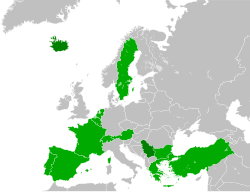International Convention on the Protection of Birds
 From Wikipedia - Reading time: 4 min
From Wikipedia - Reading time: 4 min

| ||
| Signed | 18 October 1950 | |
|---|---|---|
| Location | Paris | |
| Effective | 17 January 1963 | |
| Condition | 6 ratifications + 90 days[1] | |
| Expiration | Never | |
| Signatories | 13 | |
| Parties | 13 | |
| Depositary | France | |
| Language | French | |
The International Convention on the Protection of Birds (French: Convention internationale sur la protection (des) oiseaux) is an animal welfare treaty signed in Paris on 18 October 1950,[2] ratified in 1953 by Austria, France, Greece and Monaco, and entered into effect on 17 January 1963 for 13 European countries.[3] It followed the International Convention for the Protection of Birds that are Useful for Agriculture that was signed in Paris on 19 March 1902[2][4] (which remains effective, but has been rendered completely obsolete by later treaties[5]), to extend to all species of birds. The text of the treaty was modified for the first time on 1 September 1973, and a second time on 30 March 2016.[6]
The Convention established the principle that all birds, except for a small number of species, must be protected. It does not contain a list of species entitled to protection. Parties are required to maintain closed seasons for game birds (mostly during the spring migration), comply with certain hunting method regulations, and encouraged to establish bird reserves.[5]
According to the then-Governor of the International Council of Environmental Law Cyril de Klemm (1989), the Convention "has been largely ineffective", mostly due to the relatively small number of countries that have ratified it.[5] Instead, the Berne Convention on the Conservation of European Wildlife and Natural Habitats (signed in 1979, effective in 1982) had become the "main international instrument for the protection for European birds".[5]
See also
[edit]- Agreement on the Conservation of Albatrosses and Petrels
- Animal rights by country or territory
- Bird conservation
- List of international animal welfare conventions
- Migratory Bird Treaty between Canada and the United States
References
[edit]- ^ 'La présente convention entrera en vigueur le quatre-vingt-dixième jour qui suivra la date du dépôt du sixième instrument de ratification ou d’adhésion' (Art. 11).
- ^ a b Haas, Peter M. (2017). International Environmental Governance. Routledge. p. 12. ISBN 9781351562423. Retrieved 15 February 2022.
- ^ "Convention internationale sur la protection oiseaux" (PDF). www.admin.ch (in French). Government of Switzerland. April 2016. Retrieved 15 February 2022. (PDF)
- ^ "Convention du 19 mars 1902 pour la protection des oiseaux utiles à l'agriculture". www.admin.ch. Government of Switzerland. Retrieved 15 February 2022.
- ^ a b c d Klemm, Cyril de (1989). "Migratory Species In International Law". Natural Resources Journal. 29 (4). University of New Mexico School of Law: 957. Retrieved 15 February 2022.
- ^ "Convention internationale du 18 octobre 1950 sur la protection des oiseaux : Chronologie". www.admin.ch (in French). Government of Switzerland. Retrieved 15 February 2022.
 KSF
KSF